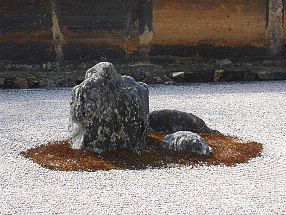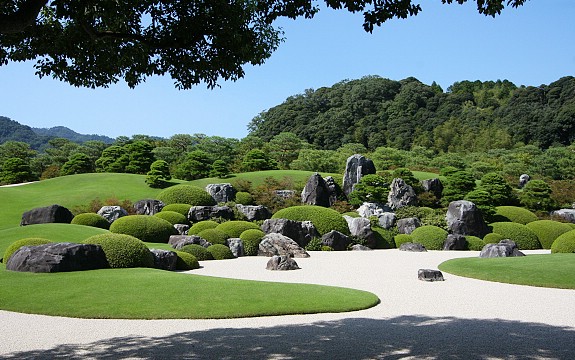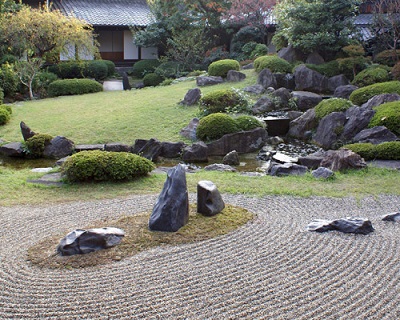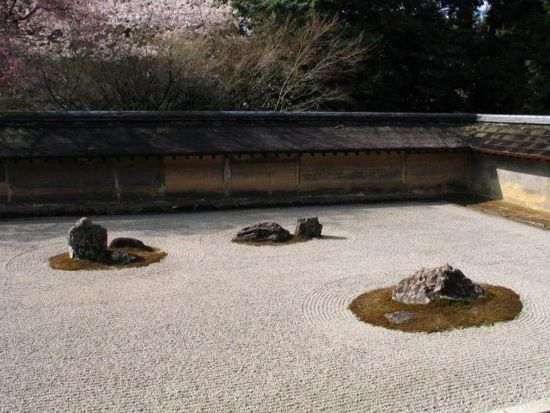Many people would be surprised to know that the word Zen means meditation derived from the sanskrit word.
A Zen Garden makes you contemplate and think, it is spiritual and for Japanese it is an extension of life itself. It is supposed to bring in peace and serenity into your life. From the western point of view it is a rock garden that looks different to any other creation man has made , making use of natural elements. Whatever the thoughts and feelings are a Zen garden or the Japanese tradition of rock garden consists of a few simple and natural elements combined together to create a tranquil, stark and symbolic arrangement . Zen gardens traditionally consist of sand, gravel, stones and water and carry an austere look that is quite unique.
These artistic gardens which are extremely pleasing to the eye , visually stunning and consist mainly of fine gravel or sand that is raked in various artistic patterns, and larger rocks which are strategically placed throughout the gravel bed. These gardens are symbolic of the Buddhist belief that one can achieve Zen, or enlightenment, through meditation and deep relaxation.
I have had the pleasure of visiting some of the most beautiful Zen gardens in Kyota and they transpire you into a different world altogether. You marvel at what human beings can achieve with their imagination and creativity. Zen gardens provides a beautiful spot for relaxing and pondering over life alone or enjoyed with your family and loved ones.
History of Zen Gardens
When we go back into the history of zen gardens ,we see that documents show that actually the origins of these stroll gardens go back to India, where walking around a Hindu temple symbolizes walking around the spiritual center of the universe. When Buddhism was formed it adapted many customs and traditions of Hinduism . The Buddhist monks would sit in contemplation and often walk round silently through gardens and nature. India's so-called "stroll gardens" which were popular with the swamis and other religious men were later adapted by the Chinese merchants when they began practicing Buddhism. This was the first step towards the formation of Zen gardens.
When Buddhism spread to Far eastern countries Japan went all out to adapt it and along with the religion many of the customs and traditions too became part of Japanese life. It was given a new look by combining the Hindu tradition with Japanese ways and Zen gardens evolved over a period and became part of Japanese way of life.
In fact going by the existing records , the art of Japanese gardens dates back to at least 592 AD and there is evidence suggesting that the art had actually been progressing long before that period, because these early gardens were very well-developed. China and Chinese ways and culture too had a lot of influence on Japanese culture and way of life. The concept of Zen garden that was brought to Japan by the Chinese monks took on a new shape when it was adapted to suit the conditions of their own country and landscape and a new style of gardening began to evolve. Japanese believe in the theory ‘ less is more’ and this theory has been beautifully adapted while creating or recreating their version of Zen gardens.
Types of Zen Gardens
Although they started with an adaptation from temple customs and rituals with migration and adaptation several different types of Zen gardens took shape. The two major components of Zen garden is sand and rock.
Karensansui or the Dry garden

Among all the zen garden type the most famous and well known is the dry garden, which is called Karesansui, which means “dry mountain, and water garden”. .which is a work of art created with rocks , sand and gravel. It is however noteworthy that the dry gardens came into being much later after the 11th century.
Often in the dry Zen garden you have one predominant feature around which the other elements revolve complementing each other and creating the total look. You often see one large rock that is the predominant feature in many dry gardens. This rock is supposed to represent the mountain/s that tower over the countryside and becomes the prominent element in a natural landscape. Most of the ancient zen gardens were very large sometimes taking the far away mountains and trees as part of the landscape and placing or planting other trees accordingly..
The Lush strolling Gardens – Tsukiyama
It is interesting to note that the ancient Zen gardens were very large, allowing for a stroll while contemplating and meditating and become one with nature . The first gardens had greenery, water features, statues, pagodas, lanterns and lush plants. Many Japanese gardens have adopted these features in their present day landscaping.
The Pagoda type of Zen garden is lush and green, with water, plants and often this form of garden is designed as a compliment to the dry Zen garden. Many such gardens have winding paths , which is a feature that was adapted by the chinese ,making their way around beautiful trees , shrubs as well as on the little wooden bridges built over streams. They also had little waterfalls and statues.
The main purpose of the Zen garden was to provide a place for meditation and contemplation although in later years it became very much part of royal palaces and monasteries. And when the Zen garden was first created by a Zen priest, it was rightly called a Contemplation Garden.When the royalty and the eminent people saw these gardens they were highly impressed by its simplicity and grace and began to create them in their own estates and that's how new variations in zen gardens began to emerge.

Kaiyu-Shikien
This is also known as a pleasure garden that was found in many rich households . Most Kaiyu-Shikien gardens had water bodies , lotus ponds, flowering trees and pet birds that were part of the landscape . Most of them have now been transformed into Japanese parks except a few that are found within the palace grounds . They may be hilly or flat gardens, and consists of some spiritual imagery such as statues and rock formations as other types of Zen gardens do.
How to make a Zen garden
The nicest thing about a Zen garden is that you do not need to have a huge piece of property or budget to create one of your own. You can do it with the land available , all that is needed is the elements and your own imagination.
Within your home
Many households nowadays have a zen garden in the corner of their sitting room which adds to the decor. The austere look of Zen gardens can be achieved when the room is large and with the right kind of furniture and color scheme can create an enchanting look within your sitting room.
Zen gardeners normally adhere to the traditional principle of yin and yang which is Earth and Water being the most important elements in life. Every facet of a Zen garden is characterized by one or the other, for example Water is yin and Earth is yang.
Creating an outdoor zen garden
Creating a dry garden is easy since it is simple in structure and easy to maintain. The most important requirement is to maintain it so that it remains clean all the time But primarily Japanese Zen gardens are made from just two primary elements - rocks and a fine, light coloured gravel , sometimes a mix of both both fine sand and coarse gravel. They do have a few living elements like plants,trees,water. But, basically it is these two humble materials namely sand and rocks that is needed to create a captivating display of form and tranquility.
To start with, one has to begin by selecting a Level area in the corner of a garden or on the terrace or balcony where you intend to have your zen space. The available garden area should be completely cleared of all weeds and plants. Once that is done use a rake to weed out any leftover roots and small twigs that might be there. Once the entire area is cleared level it out by patting down the soil .
Select the Rocks and stones that you would like to arrange. Before arranging them consider them from various angles and experiment the different looks . It is only when you do that, one is able to determine which side of the stone looks best facing upright.. Stones normally tend to look their best when partially buried in the soil with the narrow part jutting out like a mountain or a distant hill. Once the prominent feature which is the large stone or rock is in place you can arrange the other elements like smaller rocks and stones and begin by spreading the sand or gravel around it and cover the entire area.

Adding on
Traditionally Zen gardens tend to have 5 groups of 3 stones, arranged asymmetrically. This may not be possible when you have a smaller area , where you can simply have either one larger group and a smaller group in another corner. Then all that is required is to create an edge around the whole composition with brick or natural stones. Natural stones definitely look the best. The final touch is to spread 2 to 4 inches of fine sand or gravel evenly over the entire area and Rake it until you get the desired look of water flowing through the garden . You can have a circular or elongated look depending on what suits your garden best.
Once the basic zen garden is set up , you can keep on adding new features like a water body consisting of a pond or a fountain or a little waterfall, a stream and then add on a curved bridge across it. Also a few bonsai plants strategically placed add to the look . I have seen even Chinese lanterns and kites hanging from poles strategically placed also statues of Buddha or buddhist monks. But don’t overdo it, everything should be in good taste without being overbearing with its presence and be pleasing to the eye. We don’t want too many clashing colors and too many different themes and elements clashing with one another.
Modern times
Zen gardens have caught the western eye and has been adapted by many in their apartments, restaurants, even parks where you have a zen corner meant for meditating and contemplating.The very idea of a zen garden fills you with peace and harmony . It is the calm and serene theme that fills your eyes and mind that brings in such feelings of peace. Many hospitals too have an area which is zen like, stark and with the bare essentials that is used for meditation since now more physicians are aware of the effect of mind over body and how it can help cure many terminal disease.
It is astounding when you think that an idea that was Indian, later taken over by the Far easterners and developed as a fine feature which became world renowned become part of a life style of Western world, also goes to show that world has become one large place where there is a harmonious intermingling of ideas.
Some famous Zen gardens across the world
Japan has most of the very popular and famous zen gardens in the world and even among them the garden of Ryoanji Temple in Kyoto, created in 1499, is one of the oldest and the most photographed of Zen rock gardens. There is a temple within the garden and most tourists are taken on a guided tour through these gardens which normally includes a lunch sitting on Tatami mats at the Yudofuyo Restaurant as you gaze at the beautiful gardens.

There are many other gardens like Toffukui Temple garden,Shitenno-ji Honbo Garden, which is one of the oldest zen gardens, the rock garden at Kongobuji temple on Koyassan, Daitokuji at Zuihoin temple premises and so on. All of them are beautiful and some of them are dry gardens consisting of just the two basic elements whereas many others have many addded features that have been beautifully and harmoniously blended together. Even the color of the leaves and flowers have been carefully selected to give the right kind of effect . While visiting Japan a tour of these zen gardens is a must , otherwise you miss out on a rare experience of having see something that is a piece of nature but made by man - a truly marvellous feature !
